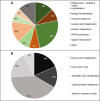Proteomic analysis of hepatic effects of okadaic acid in HepaRG human liver cells
- PMID: 38054204
- PMCID: PMC10694344
- DOI: 10.17179/excli2023-6458
Proteomic analysis of hepatic effects of okadaic acid in HepaRG human liver cells
Abstract
The marine biotoxin okadaic acid (OA) is produced by dinoflagellates and enters the human food chain by accumulating in the fatty tissue of filter-feeding shellfish. Consumption of highly contaminated shellfish can lead to diarrheic shellfish poisoning. However, apart from the acute effects in the intestine, OA can also provoke toxic effects in the liver, as it is able to pass the intestinal barrier into the blood stream. However, molecular details of OA-induced hepatotoxicity are still insufficiently characterized, and especially at the proteomic level data are scarce. In this study, we used human HepaRG liver cells and exposed them to non-cytotoxic OA concentrations for 24 hours. Global changes in protein expression were analyzed using 2-dimensional gel electrophoresis in combination with mass-spectrometric protein identification. The results constitute the first proteomic analysis of OA effects in human liver cells and indicate, amongst others, that OA affects the energy homeostasis, induces oxidative stress, and induces cytoskeletal changes.
Keywords: HepaRG cells; liver proteome; okadaic acid.
Copyright © 2023 Wuerger et al.
Figures





References
LinkOut - more resources
Full Text Sources
